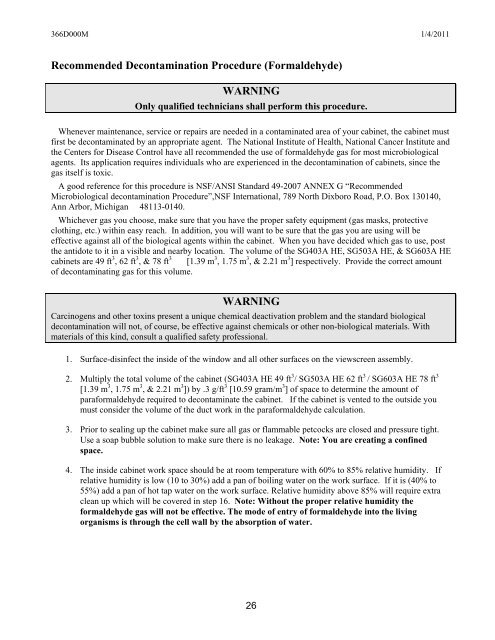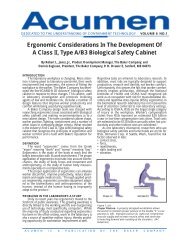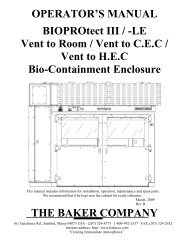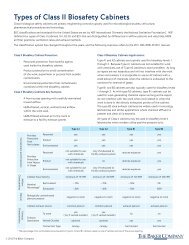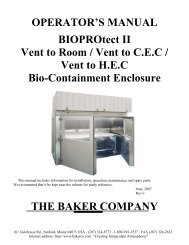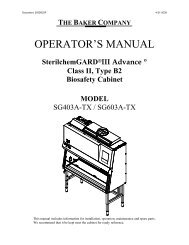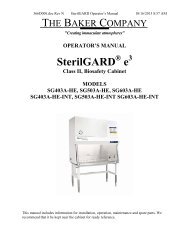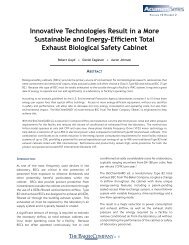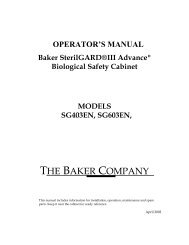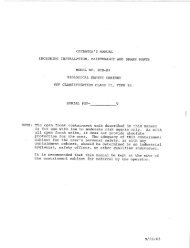OPERATOR'S MANUAL - The Baker Company Blog
OPERATOR'S MANUAL - The Baker Company Blog
OPERATOR'S MANUAL - The Baker Company Blog
Create successful ePaper yourself
Turn your PDF publications into a flip-book with our unique Google optimized e-Paper software.
366D000M 1/4/2011Recommended Decontamination Procedure (Formaldehyde)WARNINGOnly qualified technicians shall perform this procedure.Whenever maintenance, service or repairs are needed in a contaminated area of your cabinet, the cabinet mustfirst be decontaminated by an appropriate agent. <strong>The</strong> National Institute of Health, National Cancer Institute andthe Centers for Disease Control have all recommended the use of formaldehyde gas for most microbiologicalagents. Its application requires individuals who are experienced in the decontamination of cabinets, since thegas itself is toxic.A good reference for this procedure is NSF/ANSI Standard 49-2007 ANNEX G “RecommendedMicrobiological decontamination Procedure”,NSF International, 789 North Dixboro Road, P.O. Box 130140,Ann Arbor, Michigan 48113-0140.Whichever gas you choose, make sure that you have the proper safety equipment (gas masks, protectiveclothing, etc.) within easy reach. In addition, you will want to be sure that the gas you are using will beeffective against all of the biological agents within the cabinet. When you have decided which gas to use, postthe antidote to it in a visible and nearby location. <strong>The</strong> volume of the SG403A HE, SG503A HE, & SG603A HEcabinets are 49 ft 3 , 62 ft 3 , & 78 ft 3 [1.39 m 3 , 1.75 m 3 , & 2.21 m 3 ] respectively. Provide the correct amountof decontaminating gas for this volume.WARNINGCarcinogens and other toxins present a unique chemical deactivation problem and the standard biologicaldecontamination will not, of course, be effective against chemicals or other non-biological materials. Withmaterials of this kind, consult a qualified safety professional.1. Surface-disinfect the inside of the window and all other surfaces on the viewscreen assembly.2. Multiply the total volume of the cabinet (SG403A HE 49 ft 3 / SG503A HE 62 ft 3 / SG603A HE 78 ft 3[1.39 m 3 , 1.75 m 3 , & 2.21 m 3 ]) by .3 g/ft 3 [10.59 gram/m 3 ] of space to determine the amount ofparaformaldehyde required to decontaminate the cabinet. If the cabinet is vented to the outside youmust consider the volume of the duct work in the paraformaldehyde calculation.3. Prior to sealing up the cabinet make sure all gas or flammable petcocks are closed and pressure tight.Use a soap bubble solution to make sure there is no leakage. Note: You are creating a confinedspace.4. <strong>The</strong> inside cabinet work space should be at room temperature with 60% to 85% relative humidity. Ifrelative humidity is low (10 to 30%) add a pan of boiling water on the work surface. If it is (40% to55%) add a pan of hot tap water on the work surface. Relative humidity above 85% will require extraclean up which will be covered in step 16. Note: Without the proper relative humidity theformaldehyde gas will not be effective. <strong>The</strong> mode of entry of formaldehyde into the livingorganisms is through the cell wall by the absorption of water.26


